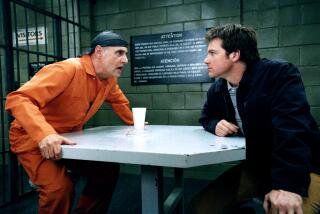Some folks call it a Slingbox
Wayne Carmona is line producer for HBO’s popular Entourage, a series that’s as much about the Los Angeles celebrity demimonde as it is about celebrity itself. It has only a few fixed sets, preferring to shoot scenes at restaurants, on the road and in other locations in and around L.A. As a result, Wayne is a very busy guy.
“I guess you could say I’m the field general for everything that’s actually seen on film,” Carmona said in a recent interview. Don’t like that metaphor? Then try these Carmona’s heard a bunch of ‘em. “I’m the go-to guy or the get-it-done guy for how to tell the story mechanically and visually. Or I’m the host of a party, or I’m the general contractor that makes sure we color within the lines and satisfy all of the storytelling requirements. And I’m the peacemaker, and I’m the deal maker, and I’m the chef that mixes all of the flavors.”
You get the point. To stay on top of his many responsibilities, Carmona cobbled together an unorthodox solution built around a tiny OQO computer and a Slingbox a device that some copyright holders have labeled a piracy tool. Now he’s got 16 Slingboxes piping video from the day’s shoot to various members of the production team, and their work is a bit easier as a result. His experience offers an important reminder for Hollywood that technology can be an ally if you embrace it, just as it can be an enemy if you don’t.
Carmona isn’t a tech revolutionary, he’s just an early adopter who likes gadgets. Eclipse Worldwide, a firm that does product placement, supplied a particularly sweet device for Entourage earlier this year: an OQO Model 2, a full-fledged computer the size of a passport (well, a 1-inch-thick passport). It has a five-inch screen the same size as an early-model portable DVD player and offers three ways to connect wirelessly to the Net: WiFi, Verizon Wireless or Sprint Nextel’s network. It’s also small enough to fit into a pocket, and light enough to be held at length in one hand. Close watchers of the show saw Carmona using the OQO in the background of one episode, and it was only a matter of time before he found a way to put the device to work for real.
That opportunity presented itself. Eclipse introduced Carmona to Jason Hirschhorn, the president of Sling Media Entertainment Group. Hirschhorn visited the set and talked up the Slingbox, a set-top box shaped like a bar of gold bullion. The Slingbox takes a home’s cable or satellite feed and retransmits it, one channel at a time, over the Internet so it can be viewed on a computer or video-enabled mobile phone. Typically, consumers use Slingboxes to watch their local TV programming when they’re off traveling for example, to watch a Lakers home game on a laptop in New York, instead of tuning in the Knicks on the hotel TV.
The device has a relatively small but fiercely loyal following, not unlike the early support for TiVo. Some copyright holders, however, aren’t so appreciative of the technology. They complain that the Slingbox circumvents regional restrictions on broadcasts and enables users to share their subscription channels (e.g., HBO) with non-subscribers. For example, an executive with Major League Baseball’s Internet division said at a conference last year that Slingbox users who watched games outside their home regions were stealing from the cable operators who paid for the rights to show games there.
Carmona saw the Slingbox in more pragmatic terms. Although numerous people involved in Entourage needed to watch what was being filmed, the only place to monitor it was at a cluster of screens near the set. After hearing the pitch from Slingbox, Carmona told Hirschhorn, “OK, hook it up to the OQO. So he did.” OQO helped as well, making sure the device’s wireless connections could handle the video signal, said Jihye Whang, the company’s director of product management. Ta-daa: Carmona was now able to watch the filming on the pocket-sized screen wherever he could get a mobile-phone signal. That freedom to move was critical to the producer, who had to keep an eye not just on the current shoot, but everything else happening on the production as well. “Our show is a very active show in that we’re on many locations, sometimes several locations in any particular day,” Carmona said. “And it’s important that all of the departments know what we’re doing, as well as what is expected of them in the future.”
Naturally, his next request was for a feed from the Slingbox that other crew members could tune in on their laptops and mobile phones, too. For legal reasons, the device transmits a video stream to only one receiver at a time. So Sling threw more units at the problem. “They built a rack of 16 Slingboxes, and eventually they set up a whole mobile configuration for the show,” Carmona said.
“By enabling more people to garner information rapidly, it does make our life a little bit easier. Producing, like any other set of tasks, is moving information. And the faster you move it, the more effectively you move it, the more information that people have, the more cogent decisions that they can make. Even though I was using all of those metaphors for production, production is really a series of tasks not unlike anything else like building a house or catering a wedding. It’s just a series of tasks that, in this particular instance, happens to be wrapped in the celebrity of notoriety. This solution I simply look at as being able to help me pass on information in a more facile way.” Whang of OQO said the approach Carmona pioneered can save money, too, by helping far-flung productions avoid costly reshoots after they’ve closed out work on a location.
It’s easy to understand why copyright owners might have misgivings about new digital technologies that can duplicate and move their works outside of their control. Still, it’s hard to predict how many of these devices and capabilities will be used. And the more quickly they’re embraced by the entertainment industry, the more likely the technologies will prove to be a net plus instead of a minus. As Carmona put it, “There are lots of solutions, they’re just looking for problems.”
Jon Healey is a Times editorial writer; he runs the BitPlayer blog.
Send us your thoughts at [email protected].
More to Read
A cure for the common opinion
Get thought-provoking perspectives with our weekly newsletter.
You may occasionally receive promotional content from the Los Angeles Times.











